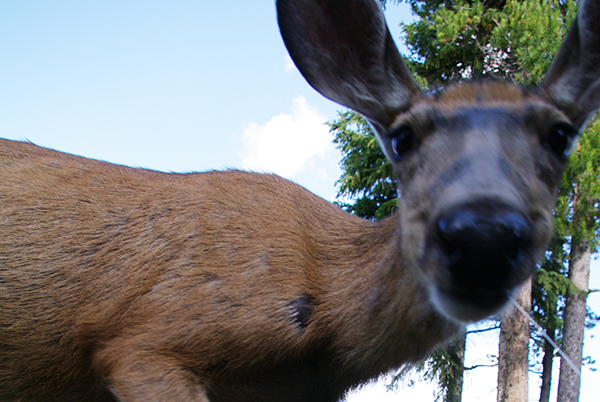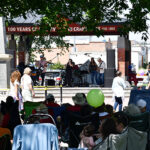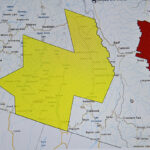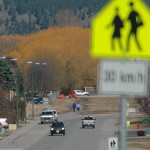Home »

Council narrowly votes against deer translocation for 2019
By Nowell Berg
On January 28, City of Kimberley council held its regular bi-monthly meeting.
Councillors Kyle Dalum, Kent Goodwin, Nigel Kitto, Jason McBain, Darryl Oakley and Sandra Roberts were present along with Mayor Don McCormick.
The Great Deer Debate
A report to council, prepared by chief administrative officer Scott Sommerville and based on the Urban Deer Committee (UDC) indicates the UDC want the mule deer herd reduced to a total of 30 animals.
This would mean the translocation of approximately 40 plus deer. The 2018 deer count came in at 77 animals. In 2017, the deer count was 158. The Managing for the Future (MFF) report of 2012 set a threshold of allowing 125 deer within city limits. In June 2018, the UDC lowered the threshold to 30 deer.
The other major point of contention arises between the city and the provincial government over the cost formula for removal of deer. Currently, the provincial program provides matching grants for the operational removal of deer for which there are only two options, culling or fencing.
Since council has said the city would only remove deer by translocation, matching operational grants are not possible. Over the past few years FLNRORD (Ministry of Forests, Lands, Natural Resource Operations and Rural Development) has offered matching grant dollars but only for a scientific study to track the movement of translocated deer. The research project option only provides cost-shared funding on a per tagged or radio-collared animal basis capped at $20,000 per year.
Sommerville’s report said council would have to budget $20,000 for the 2019 translocation. He noted past data shows that 25% of translocated deer will return to an urban centre. In this case, the city would have to cover the cost of “destroying” 10 deer along with their off-spring.

To lead off, Mayor McCormick requested the original motion before council be replaced by his motion: “We do not translocate mule deer in 2019.” It was seconded by Coun. Oakley.
This touched off a significant debate between councillors in favour of continued translocation and those opposed.
McCormick led off by making two points. First, the city has been using the number of deer deemed acceptable as 125 based on the MFF report. He pointed to the deer population within the municipal boundaries as reported by the UDC (77) being well short of that threshold, therefore, translocating deer in 2019 was not necessary.
His second point was that FLNRORD (the Ministry) was placing conditions on the city’s translocation license that he considered “unreasonable and unacceptable.” The key condition being that the City of Kimberley would be responsible for dealing with translocated deer that wander back into another urban area, usually Canal Flats.
“Its a slippery slope; if we’re taking responsibility to take deer out that came from Kimberley where does that stop,” he stated. “No way we can take responsibility.”
To counter this position, Coun. Goodwin stressed it was important to continue the removal of deer to get the numbers down to around 30, a sustainable number in his opinion. He stated, “I couldn’t disagree more with your [the Mayor’s] position on that. We are very close to achieving our goal of getting the deer down to a sustainable number.”
He raised the issue of deer human interactions and the need for public safety, citing several events where confrontations led to serious injury to pets and people. Fewer deer, better public safety and “better for the deer.” Adding, “We are not running a zoo in Kimberley. Animals should live in natural habitat,” he said. As for the FLNRORD conditions, they are “onerous, wish it didn’t happen but see the logic behind it” as part of the translocation process.
Coun. Roberts expressed concern about the UDC’s “value” if councillors were going to ignore its recommendation and not proceed with translocation. The UDC, established by the city and composed of animal experts and professionals, endorsed translocation using the best available information and science. UDC “made the recommendation to lower the deer total to 30,” so, why would council reject its recommendation she asked.
The mayor responded: “We have a lot of hangers-on with respect to the debate about what we’re doing. Most of the debate is about whether translocation is a viable option.” He said the ministry “continues to drag us into a scientific study. We are not about doing scientific studies.” The deer issue consumes a lot of staff time and taxpayer dollars, and it would be “extremely naive for anyone to think if we get the number to 30 our problem is over.”

While Coun. Oakley agreed with many points from both sides of the issue, he stated that moving deer out of an urban area is provincial responsibility. He disagreed with the ministry shifting the cost burden onto the city.
His main issue with the process of translocation is: “We’re being downloaded on by FLNRORD which is what I really get angry about very frustrated with it. Not only the extra cost but it’s a massive amount of time for us to deal with an animal that ends up in another community. As far as I’m concerned we should be allowed to translocate and if a tagged animal shows up in another community that is FLNRORD’s responsibility.”
He suggested the MFF document number needs to be revamped and brought up-to-date with a new number, but “proven with science what the number should be.”
Coun. McBain indicated it was good have this discussion and that it was time to get new numbers regarding what the maximum number of deer should be in the municipality. He asked if the previous deer count included various sections of town, which have differing numbers.
Coun. Oakley replied the count was done by the community.

Reiterating his argument to continue translocation, Coun. Goodwin said council and the city needed to take a “big bite now” out of the deer population so that future numbers of translocated deer would be manageable. If translocation is postponed, it would allow deer numbers to increase well over the 125 threshold which he stated was just a “shot in dark” made by the MFF report.
Coun. McBain replied the city needed “consistency of messaging” when it came to the number of deer found in the city.
The city has used 125 in the past and should continue to do so until the number is revised. “We need to refine the number, we need to update that number in order to be consistent with messaging, he said.” Later he added there was a lot of “anecdotal evidence” being thrown around regarding how many deer should be allowed to remain in town. Letting emotion and lack of scientific data run things would only lead to a bigger mess down the road.
Noting that his dog had been on the “receiving end of a deer attack,” Coun. Dalum stated, “Why do we need deer in town? What benefit do deer serve?” He also concurred that the 125 number needed to be “refined.” He went on to say that “urban animals should not be kept in town.” Wild animals should be in the wild. He concluded his comments saying he would vote in favour of stopping translocation “until the 125 number is changed.”
Coun. Roberts made a final comment: “In June, the experts [UDC] came up with a new number. What more do we want from these people, they’ve given us a direction that is quite clear and we’re choosing to ignore it.”
Mayor McCormick went back to his main argument that “the FLNRORD requirement to have Kimberley responsible for translocated deer in other areas” was unacceptable and reason enough to halt translocation this year.
The mayor’s motion that mule deer translocation not happen in 2019 passed four votes to three. In favour of no translocation were councillors Dalum, McBain and Oakley. Opposed to the mayor’s motion were councillors Goodwin, Kitto and Roberts. The mayor broke the tie voting in favour of his motion.
There will be no deer translocation in 2019.
2018 city finances in the black
 City chief financial officer Jim Hendricks presented council with an update on 2018 finances, saying, “were looking good.” Although he noted the numbers are not audited and will likely change somewhat from that process.
City chief financial officer Jim Hendricks presented council with an update on 2018 finances, saying, “were looking good.” Although he noted the numbers are not audited and will likely change somewhat from that process.
The standout number for Hendricks was that expenses were “under budget” which would “allow for a contribution to reserves.” He went on to say, for 2018, the city will “end up in great shape.”
Mayor McCormick asked about several “parks projects not done because of a lack of bids which is discouraging.”
“We’re having a really hard time for whatever reason. We can’t get local bidders. We hope to have better luck in 2019,” replied Hendricks.
Answering the mayor’s question on why this might be happening, Hendricks said, “In large part it has to do with contractors [being] really busy.” Even casting farther afield to Alberta did not turn up any interest from contractors.
Observing that the Civic Centre and Marysville Arena costs are slightly over-budget with less revenue, Coun. Oakley asked if there was anyway to “recover” the loses
As for the low arena revenue, Hendricks said that if hockey play-offs occur they should off-set any lose.
Oakley also noted community halls “are under utilized,” which he felt was “odd” as they were a “good deal.”
Hendricks replied, “The revenue brought in by community halls is not significant to begin with. I’m not sure why the under utilization in 2018.”
Mayor McCormick suggested the Conference Centre takes events away from the community halls. He noted capacity and food availability were reasons organizations were “opting for the Conference Centre.”
The Mayor wrapped up by issuing “kudos” to staff for “managing inside the lines, its outstanding, no surprises” with the financial affairs and operations of the city.
Bylaw Enforcement – Usual Suspects
While December 2018 was a slow month for bylaw infractions, derelict, abandoned and unlicensed vehicles left on city streets topped the list. A total of 11 notices were issued to residents regarding the removal of such vehicles from city streets. In all cases, compliance was achieved.
With winter in full swing, there were four written notices issued to residents for depositing snow on the streets or impeding snow removal.
Unattached trailers sitting on city streets drew three notices. Two were removed by residents and the other resident obtained a street occupancy permit.
Residents and visitors should take note, “The Bylaw Officer is patrolling downtown Kimberley for members of the public smoking in non-permitted places, such as public bridges and the Platzl.”
Kimberley city council meets twice monthly starting at 7 p.m. and it’s open to the public.
The next regular council meeting is scheduled for February 11.
e-KNOW








